The seven Thanksgiving dinner tweaks that will save you hundreds of calories – and make your feast instantly healthy
The average American will consume about 4,000 calories during Thanksgiving – twice as many as an adult’s recommended daily intake.
And for those on a diet, the day can be filled with endless worries about counting calories, portion sizes and overeating.
However, dietitians provided DailyMail.com with seven simple tips to make Thanksgiving staples more nutritious and, in some cases, lower in calories.
The experts say you don’t need to make drastic changes or deprive yourself of the holiday treats you love.
The following tweaks can ensure you don’t throw your weight loss progress out the window…
Turkey breast patted thighs
It is the centerpiece of your Thanksgiving feast. And if you’re on a diet, dietitians recommend choosing some parts of the bird over others.
“If people are trying to save calories or fat, the best choice is the turkey breast,” says Lyssie Lakatos, dietitian and co-founder of the Nutrition twins in New York, previously told DailyMail.com.
This is because turkey breast is made with white meat, while the legs and thighs contain dark meat, which typically contains less fat and therefore fewer calories.
Also: avoid the skin. Yelena Wheeler, registered dietitian with the National Coalition on Health Care, told DailyMail.com: ‘Turkey is a relatively low-fat, high-protein food. However, turkey skin can become quite greasy.”
Three ounces of turkey breast contain 140 calories and 0.6 grams of fat, while a turkey leg with the skin on contains 190 calories and 10 grams of fat, according to the United States Department of Agriculture (USDA).
Michelle Routhenstein, cardiology dietitian and founder of Entirely Nourished, told DailyMail.com: ‘Roast your turkey with fresh herbs such as parsley, garlic and thyme to add flavour, meaning you can use less salt, which can raise blood pressure .
“Age it in its own juices instead of adding more butter, to reduce the saturated fat.”
Swap the butter and cream for stock and Greek yogurt
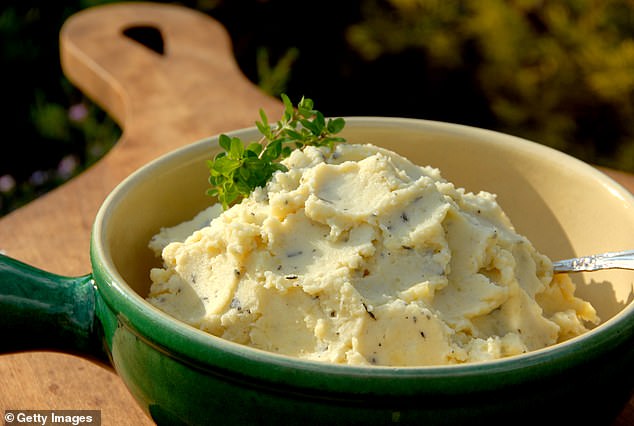
Using chicken stock instead of butter or cream in mashed potatoes reduces the number of calories while maintaining the creamy texture
In themselves, potatoes are a healthy vegetable that are good sources of essential nutrients such as vitamin B6, vitamin C, fiber and potassium.
However, butter, milk and cream can add extra calories and saturated fat, which can add to the waistline and pose problems for heart health in large quantities.
For example, one cup of homemade mashed potatoes contains 240 calories, with about two-thirds of the daily recommended amount of saturated fat.
Saturated fat has been linked to increased cholesterol – the fatty substance that builds up in the arteries – which can increase the risk of heart attack and stroke.
Ms. Routhenstein suggests replacing butter and cream with low-fat Greek yogurt and vegetable stock to lower the saturated fat content.
Greek yogurt is also packed with muscle-strengthening protein – 20 grams per cup – potassium, zinc and vitamins B2, B5 and B12.
Ditch store-bought gravy and make your own
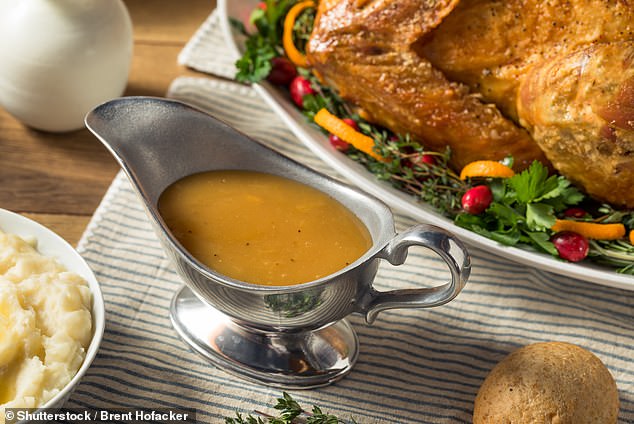
Cardiology specialist dietician Mrs. Routhenstein suggested increasing the nutritional value of gravy with mushrooms and onions. She said these contain zinc, selenium and magnesium, all of which support immune system health
Liquid and powdered gravies you can buy at the store are convenient, but they can also be packed with salt, which contains sodium – the mineral that’s bad for blood pressure.
According to the USDA, half a cup of liquid gravy contains 424 milligrams of sodium, more than one-fifth of the American Heart Association’s daily recommended limit of 2,300 milligrams.
Meanwhile, a pack of gravy granules contains about 370 milligrams of sodium, 15 percent of the recommended daily intake.
Thicker types of gravies that have flour added can also contain extra calories.
Ms. Wheeler recommends skipping the store-bought variety and making your own by boiling turkey bones in water and adding a small amount of salt.
Ms. Routhenstein suggested improving nutrition by adding crimini mushrooms and sweet onions. She said these contain zinc, selenium and mangesium, which support immune health.
For example, zinc is vital for metabolism, growth and development and wound healing.
Add fiber to your filling with whole wheat bread
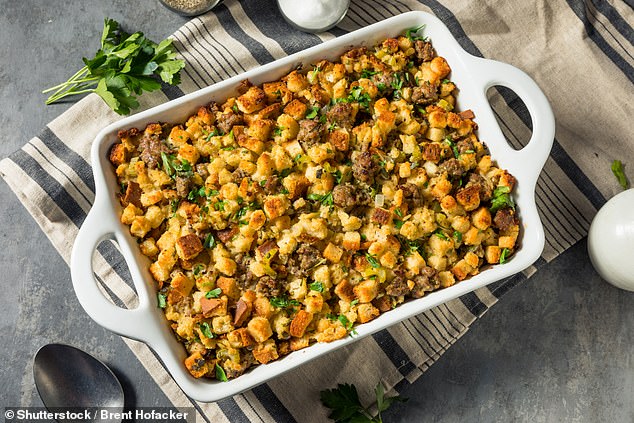
If you use white bread in the filling, you’re missing out on essential fiber, which keeps you feeling full for longer and promotes healthy digestion
Filling is a mixture of dried bread, herbs and often mixed vegetables and meat.
But experts say you should opt for whole-grain bread, because white bread can lack essential nutrients like fiber.
This is because white bread is a refined carbohydrate, meaning the most nutritious part of the grain has been stripped of its beneficial properties.
Fiber increases satiety – or fullness – so without fiber you’re more likely to go for seconds and overeat. Fiber is also known to be crucial for regular bowel movements and reducing the risk of colon cancer.
Ms. Routhenstein also said she should double the amount of carrots, celery and onions to boost vitamins and minerals while increasing feelings of fullness without the added calories.
Sprinkle cinnamon over sweet potatoes
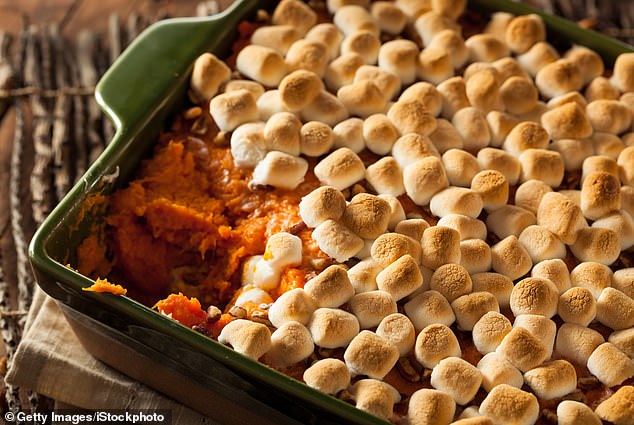
Sweet potatoes are naturally sweet, so not much sugar or other sweeteners have been added to the dish
Sweet potatoes are a common Thanksgiving side dish and often one of the sweetest options on the menu.
Some of the most popular variations are those covered in sugar, syrup or marshmallows.
Since sweet potatoes are already sweet, as the name suggests, these additions are not necessary, according to Mr. Wheeler.
“Opt for cinnamon as a flavoring instead, as it has virtually no calories,” she said.
Sweeten the cranberry sauce with juice, not sugar
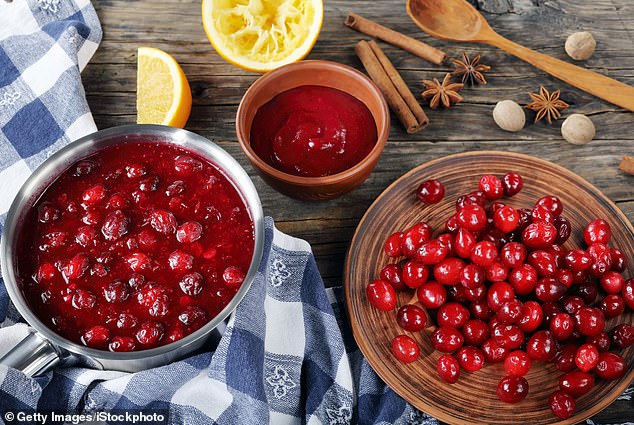
Using orange juice instead of sugar adds sweetness to the cranberry sauce and also contains a hint of extra vitamins
Loading up on cranberry sauce is one of the easiest ways to accidentally eat too much sugar at Thanksgiving dinner.
Some store brands of cranberry sauce even contain 30 percent sugar. And even homemade brands can have too much if you’re not careful.
According to the USDA, one cup of sweetened cranberry sauce can contain up to 88 grams of sugar, which is more than twice the American Heart Association’s recommended daily allowance.
Ms. Routenstein recommends sweetening your cranberry juice with low-sugar orange juice and zest. Although orange juice still contains sugar, it’s likely a lower amount than you would in table sugar, and you’ll get a “boost of vitamin C and antioxidants.”
Make a graham cracker pie crust – or eat the center
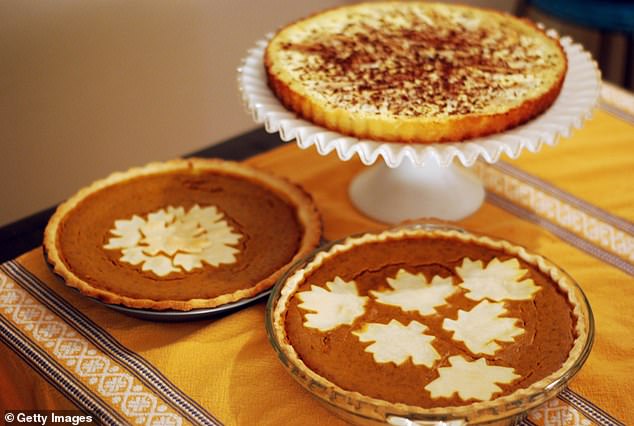
Nutritionists recommend eating the filling from the pies or using a graham cracker crust to reduce calories and fat
For many, dessert is the highlight of the Thanksgiving meal.
In particular, pumpkin pie is a staple that’s packed with nutrients like vitamin A, which promotes eye health and the immune system.
However, the crust contains a lot of fat. A slice of traditionally baked pie crust contains about 100 calories and eight grams of fat — about the same as a Mars bar.
One option is to just eat the filling. But another way to reduce your fat intake is to make your pie with a graham cracker crust, which has about the same number of calories with half the fat.
However, Ms. Routenstein said it’s okay to enjoy dessert, especially during the holidays.
‘Some things are best kept traditional. If pumpkin pie is your favorite dessert at Thanksgiving, enjoy a guilt-free slice with a balanced meal,” she said.
